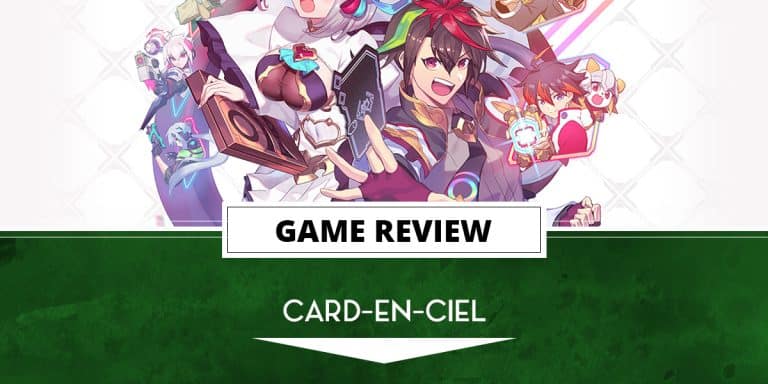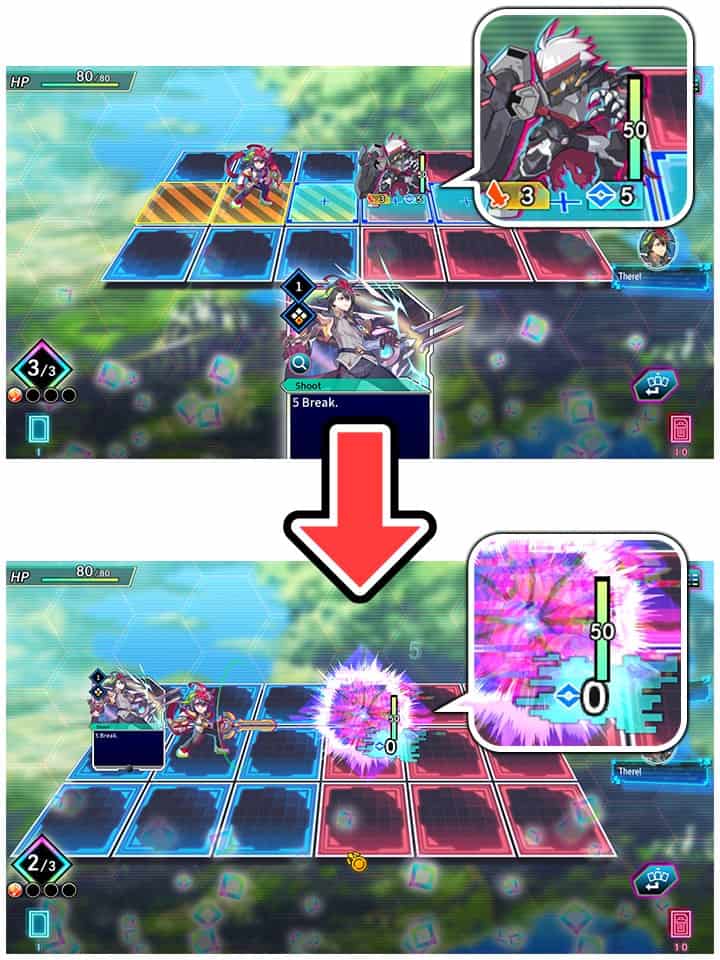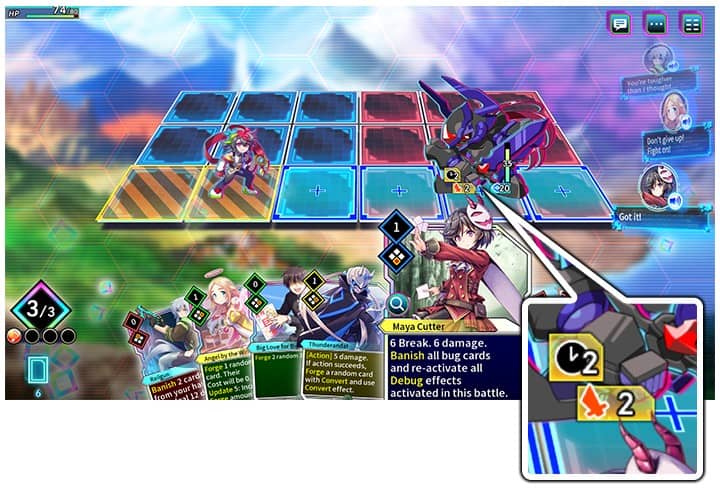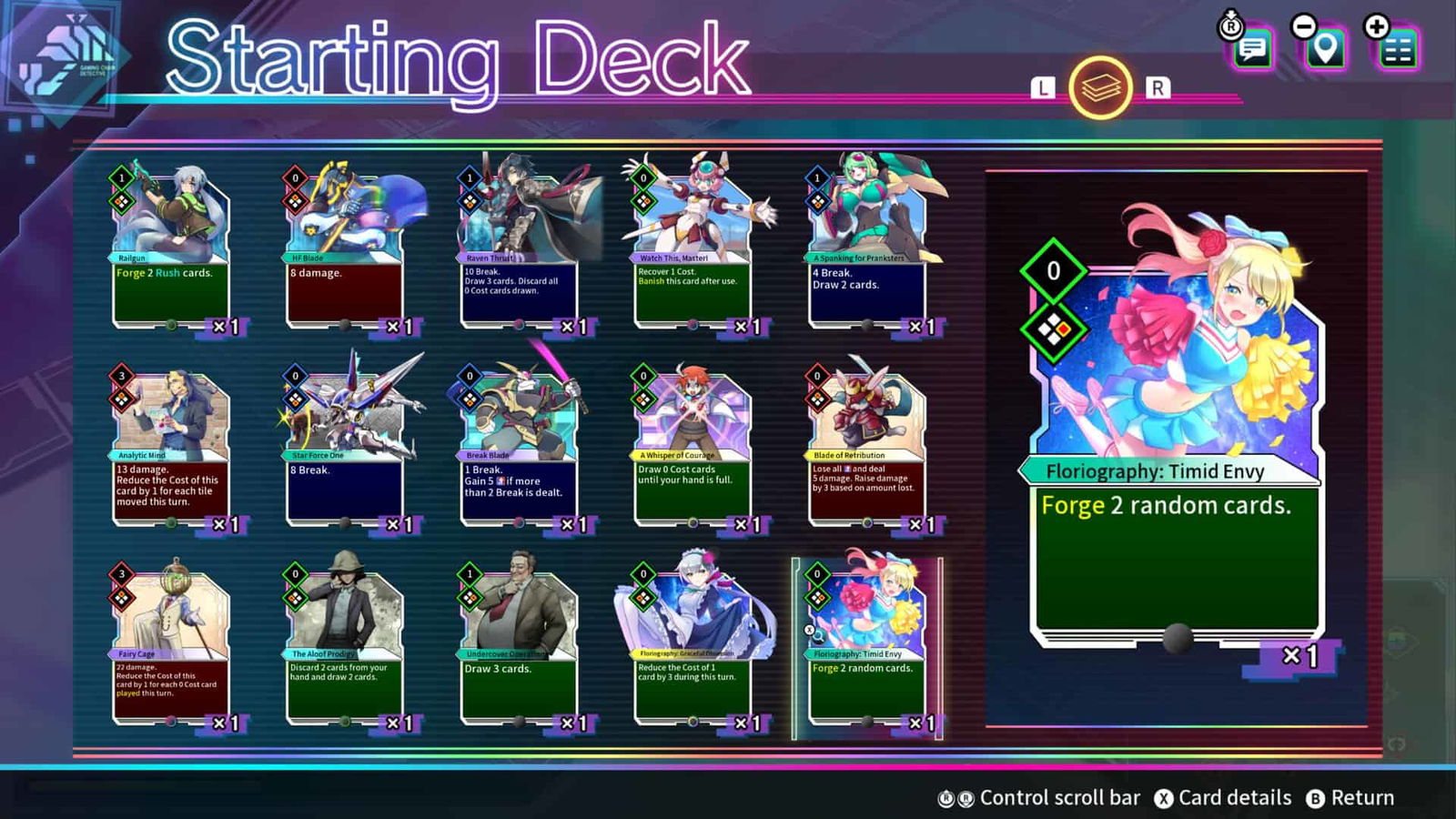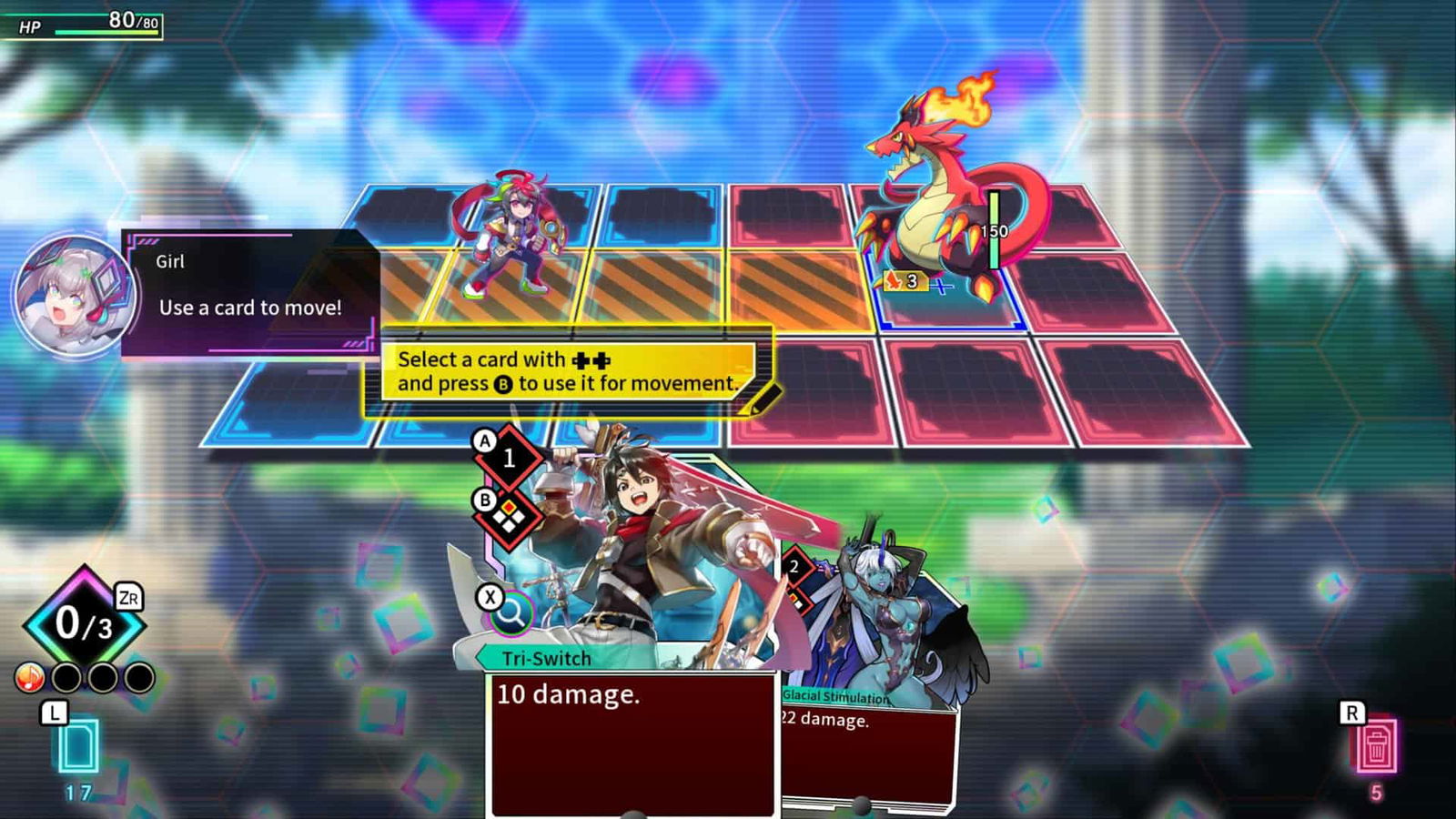I originally fell in love with Inti Creates with their Mega Man Zero series and, later, their Azure Striker Gunvolt series. While they’ve had a patch of hits and misses, they have dared to do something different, and that something different is Card-en-Ciel, a roguelite deck-building turn-based battle game. Whew… that’s a mouthful. Does this anime-themed dungeon crawler (hey, more adjectives!) cause them to bounce back and give them a legitimate hit?
Title: Card-en-Ciel
Platform: PC (Reviewed), Nintendo Switch, PlayStation 4/5, Xbox One/Series S|X
Developer: Inti Creates
Publisher: Inti Creates
Release Date: September 4, 2024
Price: $24.99
A Game of Many Adjectives
Card-en-Ciel may have a lot of genres and adjectives attached to it; however, what it boils down to is that it is a dungeon crawler where you fight enemies using cards. You win, get more cards, you build a deck, and you face the dungeon’s boss to move on to the next dungeon. It’s a pretty simple concept with an even simpler story.
Neon is a hacker that solves crimes in the VR world. Known as the Gaming Chair Detective, he is called upon by Ancie to get to the bottom of something happening in a game called Rust Tactics. There, he discovers characters from other games have invaded and… well… that’s the story!
As you can tell, there isn’t much depth to the narrative; however, what Card-en-Ciel does is use this simple premise to host a myriad of characters from their other games, making this a massive crossover title. The fun part is that there are real and fictional games, most of them coming from Azure Striker Gunvolt and Gal Gun. Since we have Gunvolt all over the place, music and Muses play a big part in the game as well. But, you’re not here for the story… you’re here because of the addictive gameplay, right?
Play Your Way
While the story is rather shallow, Card-en-Ciel makes up for it in spades with its highly addictive gameplay but also the way you engage with the game.
As mentioned, you enter a dungeon with a starter set of cards. Use them to defeat enemies and you gain more cards. Build a deck and then challenge the boss at the end of the dungeon. The best part about this system is that there are no timers and no sense of urgency to finish a dungeon. Enemies constantly respawn so you can farm as much as you want. Because this is a roguelite, your deck resets at the start of every dungeon so you have to do it all over again but building decks and the randomness is part of the fun. The only downside here is that the number of cards you can grab is pretty limited so, sooner or later with enough farming, you’ll just get all the cards anyway.
This sets up a “play at your own pace” style of gameplay but for those who want a challenge, completing a dungeon in the fastest way possible (i.e. the fewest battles) will net you maximum rank at the end and just like in Gunvolt, that rank is depicted in medals. Although you may earn a low ranking, you’ll still advance so the game caters to different playstyles and skill levels of gamers. This is a huge plus.
The Combat
Card-en-Ciel’s combat system will be the meat of this review because this is where all of the fun happens. In short, you have cards each with their properties that you will want to try and synergize with other cards or use at the right moments for burst damage. How do you do all that? First, let’s examine all the stats on an enemy. We’ll go from right to left since it’s easier to explain that way.
On the far right of the enemy, you will see the HP gauge. Pretty straightforward. Make that number 0 to defeat the enemy and win. Below that you will see a blue diamond with a number in it. This is the break value. Reduce that number to 0 and you will stagger the enemy and cause them to take double damage!
On the left side of the enemy, you see a clock with a number on it. This is the turn counter. While, yes, this game is turn-based, enemies can still attack on your turn. Each time you use a card, the turn counter depletes by 1. If it reaches zero, the enemy will attack regardless if it’s still your turn. Also, when you pass your turn, the enemy will attack immediately so if you’re not paying attention and the turn timer hits zero and you immediately pass your turn, get prepared to get attacked twice!
The orange tile below that with the sword is the enemy’s attack power. That’s how much damage you will take if you get hit and, yes, you can also reduce that down to zero. The turn timer, the attack value, and the break value will reset back to their full amounts when you pass your turn.
Got all that? Great! Now let’s talk about how you deal with each of these numbers.
Attack Cards – These are colored red and have a value. When you use them, you will damage the enemy and deplete their health bar. Pretty straightforward!
Break Cards – These are colored blue and also have a value. When you use them, you will damage the enemy’s break value AND the attack value! Here is where strategy comes in. Do you have enough break damage to stagger the enemy? If yes, do you have enough points to spend on a follow-up to damage them? If you can’t, maybe you’ll want to spend that break card to lower the attack so when you get hit, you won’t take as much damage. So why wouldn’t you just move to avoid damage? Good question and that will be answered later and when you see the answer, you’ll understand the choices here.
Action Cards – These are colored yellow and are similar to Attack Cards but there is a difference. If you are standing in a space where the enemy will attack, and their counter is at 1, you can use an action card to force the enemy to attack. A red aura will surround the enemy and shrink. Time the button press correctly and you will counter their attack and use the action card, avoiding damage and dealing damage to the enemy. Plus, if you successfully manage to pull this off, additional effects listed on the card will trigger! A little bit of skill goes a long way with these cards!
Cheat Codes – These are colored green and are more of a utility card than anything. Cards like Forge 2 Rush cards or Draw 3 Cards, or even Discard 1 card and Draw 1 card can be found on these types of cards. They are usually low cost so you can combo them or have points left over to use the cards that you draw.
Muse Cards – These cards do not get played. They sit in your deck and activate when their conditions are met. For example, a condition could be Forge three 0-cost cards. When that happens you will get the effect of “When playing a card, Forge a number of Rush cards equal to its Cost.” Another could have a condition of Playing three 0-Cost cards in one turn with the Effect of “Gain 3 value whenever a 0-Cost card is played.” That “3 value” increases the values of your Attack and Break cards. Knowing which Muses you have allows you to craft your deck and create synergies.
So, what were things like Forge and Rush that you mentioned? These are Special Skills. For example, a card with Convert that deals 5 damage can deal 20 damage when Converted. To activate a special skill, you press a button and activate a Muse’s song. Doing this will destroy the card (for the battle, you still keep the card for the next battle); however, if you activate a Muse’s card by fulfilling their conditions, you can activate Special Skills on a card without destroying it.
Wild Cards – Lastly, you can set Wild Cards before you enter a dungeon. These are cards in your collection that you can call upon whenever you need it but the tradeoff is that you can only draw that card once per dungeon run. Best to set a Wild Card for a boss and pull it out when you know you’re going to need it.
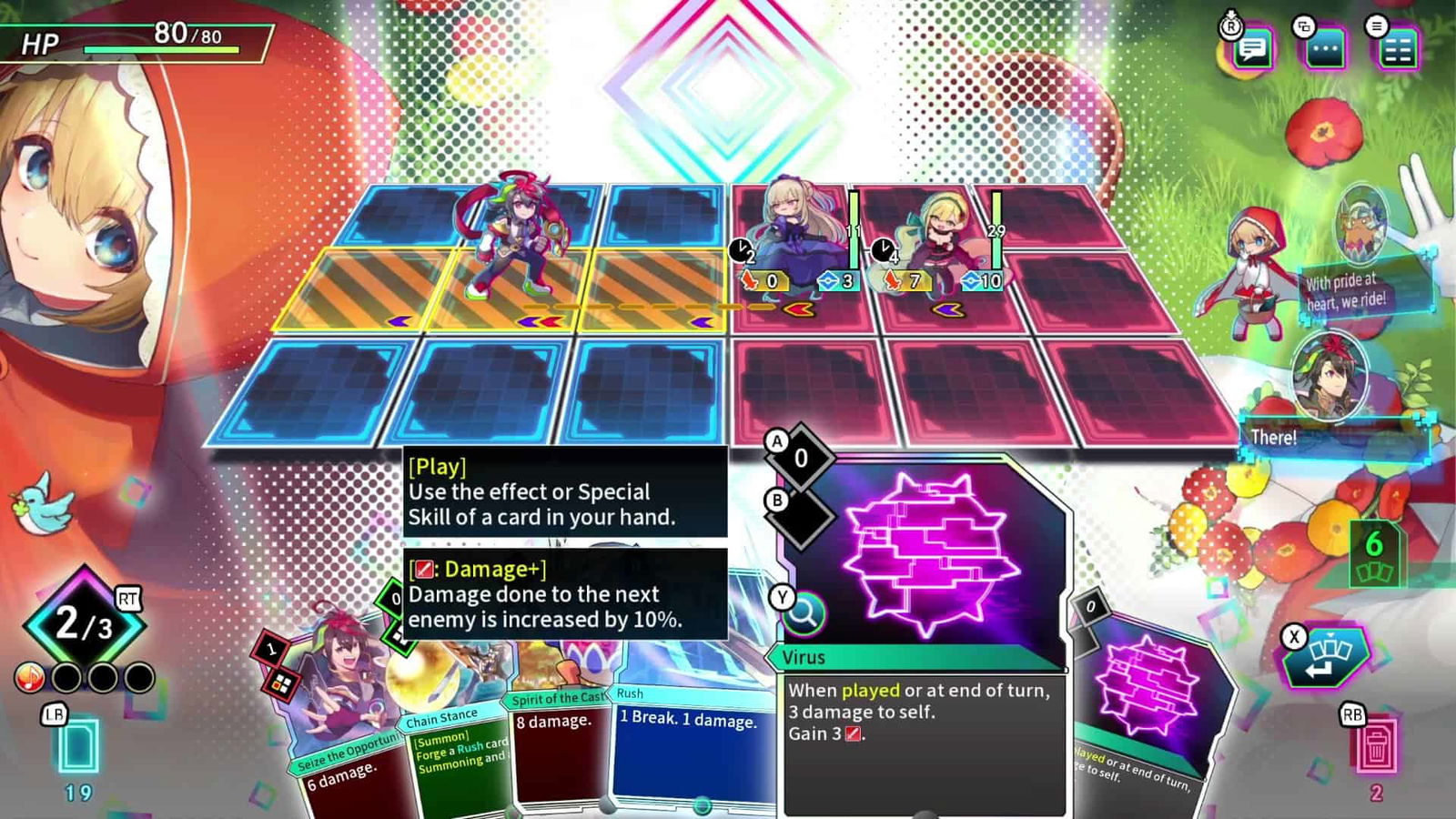
With the cards explained, I mentioned something about moving. This is the other half of the battle system.
For those familiar with Mega Man Battle Network, you and the enemy/enemies are positioned on a 3×3 grid. 9 tiles for you, 9 tiles for the enemy. Your titles will light up with a caution graphic which will indicate where the enemy will attack once you pass your turn (or their turn timer reaches 0 during your turn). To avoid these attacks, you need to move but you can’t just press the D-Pad or analog stick to move your character. You move using your cards.
Every card has a fixed direction… Up, Left, Down, and Right. So now more strategy comes into play as you need to decide to use a card to attack/break or to move. Can you reduce an enemy’s break gauge and stagger them? Can you lower their attack to 0? If so, you may not need to move but if you can’t, you’ll want to consider dodging to avoid the attack, passing your turn, and trying again next round. Using a card to move doesn’t cost any points so you can keep moving as long as you have cards in hand.
This is where RNG plays a factor. If you have cards but don’t have the directions you need to move AND you don’t have enough points and/or cards to cause a break or lower their attack, then you just have to eat the damage and you don’t have much control over that. As in-depth as this battle system is, that is the one glaring flaw of it… the RNG. This RNG can also make or break a boss fight, which can be frustrating after going through each floor of the dungeon to get to said boss. The Wild Card can alleviate that if you wipe a time or two but it’s still a bit of a flaw in an otherwise amazing system.
The Addiction
With a combat system that can be as simplistic or as in-depth as you want it to be, the gameplay becomes very addictive. Even if you lose and have to start the dungeon all over again, the pace of the battles is very quick and can typically be ended within 1-3 turns, some mini-bosses aside as they can pose a bigger challenge. For example, the first dungeon beyond the tutorial, Kizuna Connect, has three floors and can be completed in about 15 minutes IF you get into every single battle. Even faster if you skip battles and go straight for the boss and only pick up necessary cards along the way.
The anime-themed characters, the crossover characters, the great soundtrack (even though a lot of the music is ripped straight out of other Inti Creates titles), and even the English voice acting are all well done and will provide hours upon hours of fun.
Plus, when you complete dungeons, you will earn tokens which will permanently increase your chances of finding rare cards, treasure chest, cheat codes, and more within dungeons, or even power-up your character by increasing your health pool. What you get is RNG though as you are presented with 3 random upgrade choices. You do; however, earn enough tokens to pick a couple of them each time you stop off at the upgrade menu, though.
Also, if you want to just have a blast without the stress, there is an easy mode. The biggest difference is that you get 3 Continues on easy mode whereas on normal mode, if you die, you’re done and you have to start over.
Overall
It’s obvious that the meat of this game lies within its battle system and despite the flaws of RNG, it wouldn’t be a card game without RNG so it’s necessary. The frustration of dying to RNG doesn’t feel bad in this game with how quickly the battles go by and how little time it takes to fully clear a dungeon. This allows you to replay the content, learn more about the enemies you encounter, and build a better strategy. You still get that satisfying feeling when you clear a dungeon which adds to the overall fun of the game.
The story leaves a lot to be desired but if you are an Inti Creates fan, you’re just there to see all of your favorite characters make a cameo appearance. After all, that’s the whole point of crossovers is to see different characters interact with each other.
While there are a lot of moving pieces to the battle system that seem overwhelming at first, it was extremely easy to pick up and play. The game has a tutorial level that you can revisit at any point as well as written explanations in case you want a quick overview. Coupled with an official Wiki that you can reference any time online, you can study up on the go and get ready for the next time you play the game when you get home… or on the go since it is also available for Nintendo Switch.
All in all, this is a very solid game that proves that simplicity often makes the best experience. Once you get used to the battle system, everything falls in place and you’ll be having a blast!
Card-en-Ciel
Card-en-Ciel Offers a Unique Twists on Deck Building Roguelites
Card-en-Ciel is a fun dungeon-crawling deck-building roguelite that will provide hours of addictive gameplay that is easy to pick up and learn. While the system seems in-depth and daunting, its thoughtful design appeals to gamers or any skill level.
Pros
- Excellent battle system
- Great soundtrack
- Crossover characters from other Init Creates properties
- Easy to pick up and learn
- Designed for multiple skill levels
Cons
- RNG can lead to frustration
- If playing on normal, having to restart dungeons after dying


